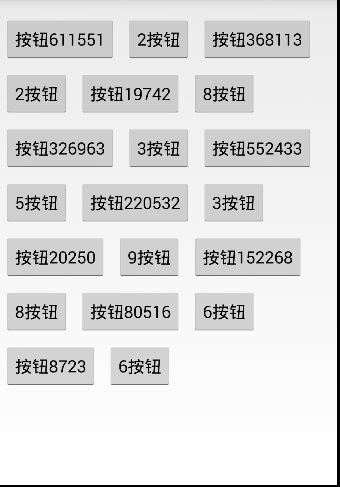
这就是我们要实现的流式布局。
难点就在于如何控制子View的布局,动态的判断是否将子View放置在下一行。
很明显,我们需要写一个类来继承ViewGroup。
package com.example.demo.autolinefeedlayout;
import android.content.Context;
import android.content.res.TypedArray;
import android.util.AttributeSet;
import android.util.Log;
import android.view.View;
import android.view.ViewGroup;
import android.widget.Button;
public class AutoLineFeedLayout extends ViewGroup {
private static final boolean DEBUG = true;
private static final String TAG = "AutoLineFeedLayout";
private int paddingLeft = 0;
private int paddingRight = 0;
private int paddingTop = 0;
private int paddingBottom = 0;
private int verticalSpacing = 0;
private int horizontalSpacing = 0;
private int mWidth;
public AutoLineFeedLayout(Context context, AttributeSet attrs, int defStyle) {
super(context, attrs, defStyle);
init(attrs);
}
public AutoLineFeedLayout(Context context, AttributeSet attrs) {
this(context, attrs, 0);
}
public AutoLineFeedLayout(Context context) {
this(context, null);
}
/**
* 获取布局文件中的一些值
* @param attrs
*/
private void init(AttributeSet attrs) {
TypedArray typedArray = getContext().obtainStyledAttributes(attrs,
R.styleable.AutoLineFeedLayout);
horizontalSpacing = (int) typedArray.getDimension(
R.styleable.AutoLineFeedLayout_horizontalSpacing, 0);
paddingLeft = (int) typedArray.getDimension(
R.styleable.AutoLineFeedLayout_paddingLeft, 0);
paddingTop = (int) typedArray.getDimension(
R.styleable.AutoLineFeedLayout_paddingTop, 0);
paddingBottom = (int) typedArray.getDimension(
R.styleable.AutoLineFeedLayout_paddingBottom, 0);
verticalSpacing = (int) typedArray.getDimension(
R.styleable.AutoLineFeedLayout_verticalSpacing, 0);
paddingRight = (int) typedArray.getDimension(
R.styleable.AutoLineFeedLayout_paddingRight, 0);
typedArray.recycle();
}
private void log(String string) {
if (DEBUG) {
Log.i(TAG, string);
}
}
@Override
protected void onLayout(boolean changed, int l, int t, int r, int b) {
log("l=" + l + " t=" + t + " r=" + r + " b=" + b);
int count = getChildCount();
mWidth = getWidth();
log("mWidth=" + mWidth);
//第一个子View开始放置的距离父控件左边的距离
int startOffsetX = paddingLeft;
//第一个子View开始放置的距离父控件上边的距离
int startOffsetY=0+paddingTop;
int preEndsetX;
**for (int i = 0; i < count; i++) {
View childView = getChildAt(i);
childView.measure(0,0);
//子View的宽度
int w = childView.getMeasuredWidth();
//子View的高度
int h = childView.getMeasuredHeight();
log("w=" + w + " h=" + h);
//子View的右端距离父控件的左边的距离
preEndsetX=startOffsetX+w;
//如果距离大于宽度-右间距的距离,则该子View应该在新的一行
if (preEndsetX > mWidth - paddingRight) {
if (startOffsetX > paddingLeft) {
//设置新起一行的子View到父控件的距离
startOffsetX=paddingLeft;
startOffsetY = h + startOffsetY +horizontalSpacing;
}
}
childView.layout(startOffsetX, startOffsetY, startOffsetX+ w, startOffsetY + h);
//设置下一个子view开始放置的距离父控件左边的距离
startOffsetX=startOffsetX+w+verticalSpacing;
}**
}
public void setOnItemClickListener(final onItemClickListener onItemClickListener) {
int count=getChildCount();
for (int i = 0; i < count; i++) {
final View view=getChildAt(i);
Button btn = (Button) view.findViewById(R.id.btn);
btn.setOnClickListener(new OnClickListener() {
@Override
public void onClick(View v) {
if (onItemClickListener != null) {
v.setTag(((Button)v).getText());
onItemClickListener.setOnItemClickListener(v);
}
}
});
}
}
public interface onItemClickListener{
void setOnItemClickListener(View v);
}
}
MainActivity的代码:
package com.example.demo.autolinefeedlayout;
import android.app.Activity;
import android.os.Bundle;
import android.view.LayoutInflater;
import android.view.View;
import android.widget.Button;
import android.widget.Toast;
import java.util.Random;
public class MainActivity extends Activity {
private AutoLineFeedLayout layout;
@Override
protected void onCreate(Bundle savedInstanceState) {
super.onCreate(savedInstanceState);
setContentView(R.layout.activity_main);
Random random = new Random();
layout = (AutoLineFeedLayout) findViewById(R.id.al);
View view;
for (int i = 0; i < 20; i++) {
view = LayoutInflater.from(MainActivity.this).inflate(R.layout.button, null);
Button button = (Button) view.findViewById(R.id.btn);
if ((i & 1) == 0)
button.setText("按钮" + random.nextInt(1000)+random.nextInt(1000));
else
button.setText(random.nextInt(10) + "按钮");
layout.addView(view, i);
}
layout.setOnItemClickListener(new AutoLineFeedLayout.onItemClickListener() {
@Override
public void setOnItemClickListener(View view) {
Toast.makeText(getApplicationContext(), (String) view.getTag(), Toast.LENGTH_SHORT).show();
}
});
}
}
自定义该控件的属性:
<?xml version="1.0" encoding="utf-8"?>
<resources>
<declare-styleable name="AutoLineFeedLayout">
<attr name="paddingLeft" format="reference|dimension" />
<attr name="paddingRight" format="reference|dimension" />
<attr name="paddingTop" format="reference|dimension" />
<attr name="paddingBottom" format="reference|dimension" />
<attr name="verticalSpacing" format="reference|dimension" />
<attr name="horizontalSpacing" format="reference|dimension" />
</declare-styleable>
</resources>activity_main.xml:
<LinearLayout xmlns:android="http://schemas.android.com/apk/res/android"
xmlns:tools="http://schemas.android.com/tools"
xmlns:app="http://schemas.android.com/apk/res-auto"
android:layout_width="match_parent"
android:layout_height="match_parent"
android:orientation="horizontal"
tools:context=".MainActivity">
<com.example.demo.autolinefeedlayout.AutoLineFeedLayout
android:id="@+id/al"
android:layout_width="match_parent"
android:layout_height="match_parent"
app:paddingLeft="5dp"
app:paddingRight="5dp"
app:paddingTop="20dp"
app:paddingBottom="20dp"
app:verticalSpacing="10dp"
app:horizontalSpacing="10dp" />
</LinearLayout>子View的布局文件:
<?xml version="1.0" encoding="utf-8"?>
<LinearLayout xmlns:android="http://schemas.android.com/apk/res/android"
android:layout_width="match_parent" android:layout_height="match_parent">
<Button
android:id="@+id/btn"
android:layout_width="wrap_content"
android:layout_height="wrap_content"
/>
</LinearLayout>Demo下载:
Android流式布局Demo






















 2653
2653

 被折叠的 条评论
为什么被折叠?
被折叠的 条评论
为什么被折叠?








